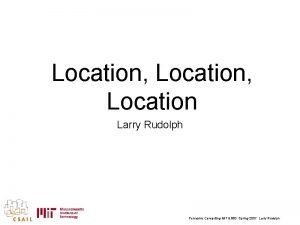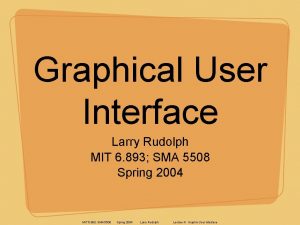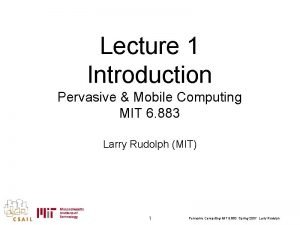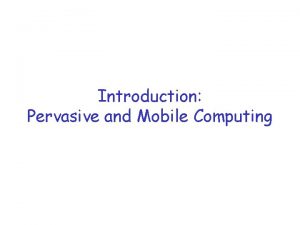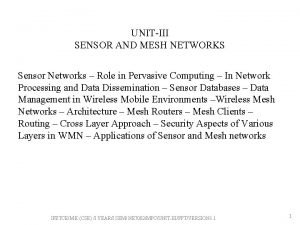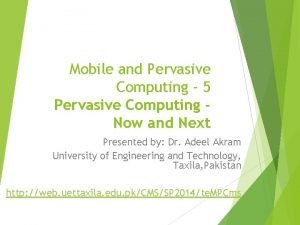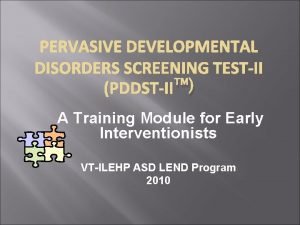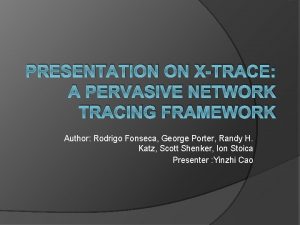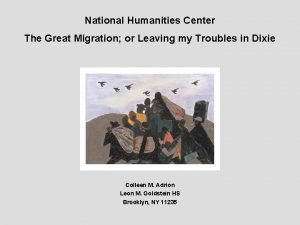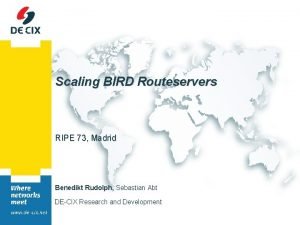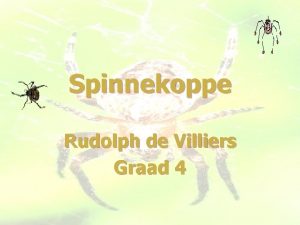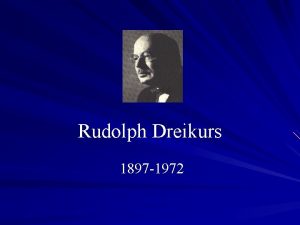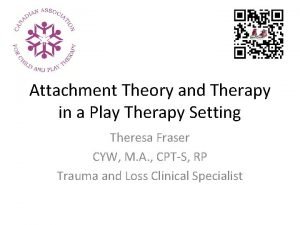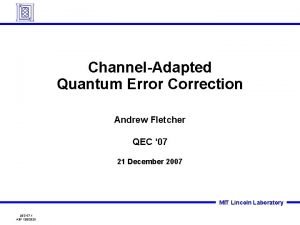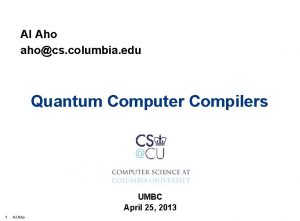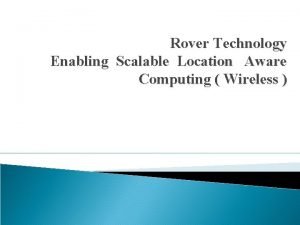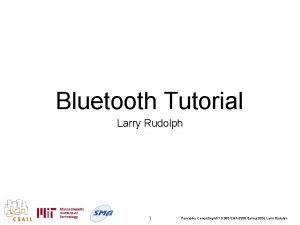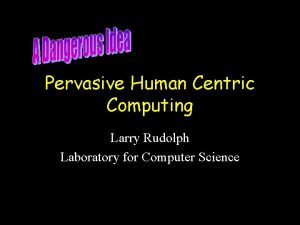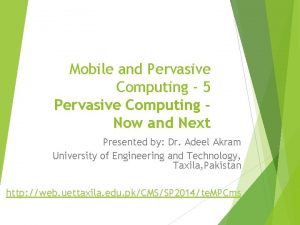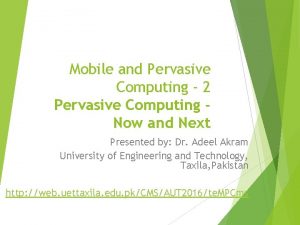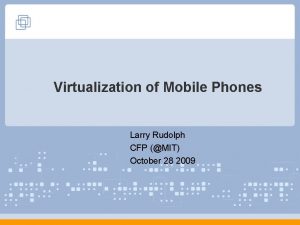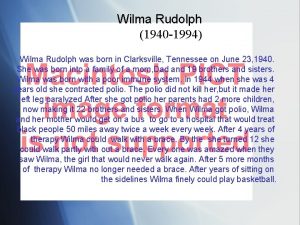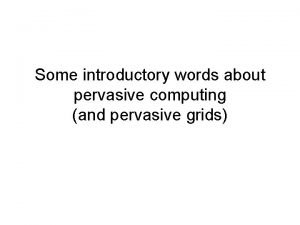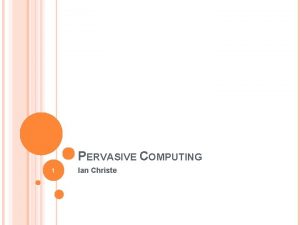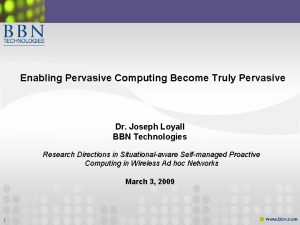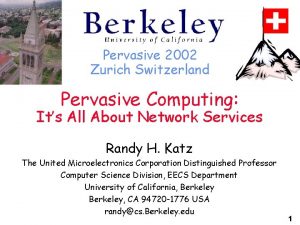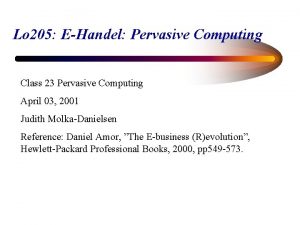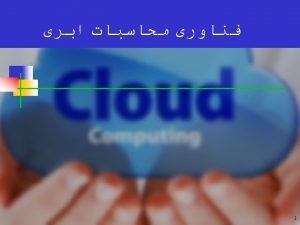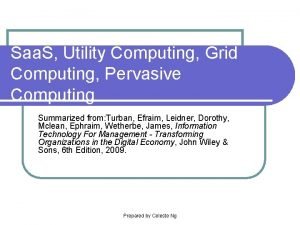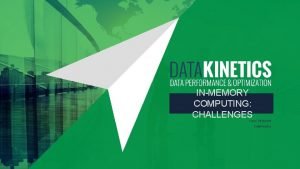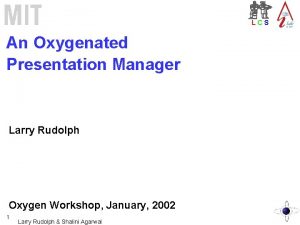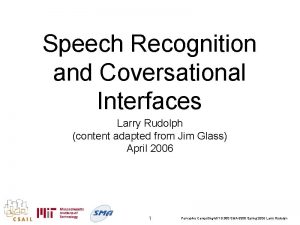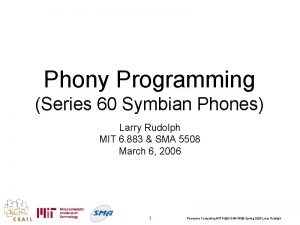Location Location Larry Rudolph Pervasive Computing MIT 6




























- Slides: 28

Location, Location Larry Rudolph Pervasive Computing MIT 6. 883 Spring 2007 Larry Rudolph

Outline • • Administrative remarks and requests Positioning Technology GPS and others Location Specifiers Privacy Issues • Pervasive Computing MIT 6. 883 Spring 2007 Larry Rudolph

Asking for help • • • For 3 rd edition phones, need to rebuild binaries. We have code for doing cache-less bluetooth scanning. I need someone to rebuild the library Let’s test theory about phone scanning Want to try to have everyone call at same time so must bring in phones. Cell tower hand-offs Discuss potential extra-credit problem set. • • • Pervasive Computing MIT 6. 883 Spring 2007 Larry Rudolph

Mobile Connectivity • • • Cellular Network (big brother) Turn on, connect to tower & register Tower’s hand-off control of phone Wifi Base Stations (proactive grown-up) Turn on; connect to station & register When signal lost, device looks for new one Is there a middle ground? Suppose there is a group of friends? • • • Pervasive Computing MIT 6. 883 Spring 2007 Larry Rudolph

How can you be found? • • Big brother keeps track of controlling tower Responsible grown-up always tells DNS its loc. Pervasive Computing MIT 6. 883 Spring 2007 Larry Rudolph

Knowing where you are? • • • Big Brother: Ask network for your location Big Family: Listen to a bunch of beacons and their locations, then triangulate Loner: Figure it out for yourself Cell tower(s) and switching pattern Notice landmarks Dead reckoning • • • Pervasive Computing MIT 6. 883 Spring 2007 Larry Rudolph

Universal Location • • • On earth, we need three piece of information: latitude, longitude, & altitude there are other possibilities Global Positioning Systems can give us that information Can then use mapping to do something useful with that information • • Pervasive Computing MIT 6. 883 Spring 2007 Larry Rudolph

Global Positioning Systems • 1978 US Department of Defense begins project • 1984 Crash of Korean Flight due to poor navigational equipment ==> gps for civilian use • 1985 Complete system fully operational • 24 satellites (11, 000 mile orbit) & $12 billion • 2000, selective availability turned off • 3 to 15 meter accuracy for everyone Pervasive Computing MIT 6. 883 Spring 2007 Larry Rudolph

How it works • • Receiver measures travel time of random code sent from satellite (about 0. 1 sec) compute distance, call it X Receiver’s position can be anywhere on a sphere of radius X with satellite at center Given four satellite readings, can figure out position in 3 dimensions Let’s look at some government slides mms. nps. gov/gis/gps/How_GPS_Works. ppt • • Pervasive Computing MIT 6. 883 Spring 2007 Larry Rudolph

GPS • Python interface to a bluetooth gps • Connect to the GPS normally: from socket import * sock = socket(AF_BT, SOCK_STREAM) • Read input from ‘$’ up to a ‘r’ character using the sock. recv(1) command (reading one byte at a time). Pervasive Computing MIT 6. 883 Spring 2007 Larry Rudolph

GPS (cont) buf = sock. recv(1) while buf != ‘$’ : buf = sock. recv(1) while buf[-1] != ‘r’: buf += sock. recv(1) if buf[0: 6] == “$GPGGA”: (GPGGA, utc. Time, lat, ns, lon, ew, postfix, sats, hdop, altuni ts, sepunits, age, sid) = buf. split(“, ”) latitude = float(lat) longitude = float(lon) Pervasive Computing MIT 6. 883 Spring 2007 Larry Rudolph


Information gotten from: http: //home. pacific. net. au/~gnb/gps/nmea. html

GSM Cellular location • • GSM mobile telephone network: cells towers fixed, signal available indoors unaffected by “urban canyon effect” Cell. ID: detect base transceiver stations (BTS) phone is registered with a BTS usually, but not always, the closest one • • Pervasive Computing MIT 6. 883 Spring 2007 Larry Rudolph

GSM Cellular Location • Cell size depends on terrain & number of users • Error: about 500 m (urban) to 15 km (rural) • Base stations have 3 antennas, 120 degree sectors Pervasive Computing MIT 6. 883 Spring 2007 Larry Rudolph

Enhanced Method • • • E-OTD: Enhanced observed time difference Time from base station to phone Time from base station to fixed location Ratio gives better estimation of position Also use triangulation (from several bases) Both yield order of magnitude improvement and lots of research for even better results • • Pervasive Computing MIT 6. 883 Spring 2007 Larry Rudolph

What good is GPS? • It is universal • But is it what we want? • Human-centric versions of location: • name of place • map of place Pervasive Computing MIT 6. 883 Spring 2007 Larry Rudolph

Other Data Formats • • • Geographic Information System (GIS) developed set of XML descriptions static (river): Geo Markup Language dynamic (cars, events): Point-of-interest NVML: Navigation mark-up language SKi. CAL: i. Calendar VEVENT used to describe event information event meta-info: location • • Pervasive Computing MIT 6. 883 Spring 2007 Larry Rudolph

Spatial Databases • Set of functions to • quickly search, query, analyze spacial info • how objects spatially relate to each other • many geometry types and typical queries Pervasive Computing MIT 6. 883 Spring 2007 Larry Rudolph

People don’t speak GPS • Different people have different views of the world. Pervasive Computing MIT 6. 883 Spring 2007 Larry Rudolph

Places -- big and small • • People refer to location as places countries, cities, towns, streets, buildings rooms, spaces within buildings relation to other places, e. g. across from Starbucks GPS is too precise map or building planand may require accurate Jim might be at 42. 3325 N, -71. 11861 E but is he in the shower at the moment? • • • Pervasive Computing MIT 6. 883 Spring 2007 Larry Rudolph

Location Tracking: Good, Bad, or Ugly? • Not too many people seem to be concerned about location-based services tracking them. • “You have no privacy, get over it” • -- Scott Mc. Nealy, CEO Sun Pervasive Computing MIT 6. 883 Spring 2007 Larry Rudolph

Can we study this? • Before investing heavily in location- based services, we should find out if people will use them. • The evidence is still mixed Pervasive Computing MIT 6. 883 Spring 2007 Larry Rudolph




Does Age Matter? • Not much in this sample of 23 participants. • surprising result Pervasive Computing MIT 6. 883 Spring 2007 Larry Rudolph

Their Conclusions Pervasive Computing MIT 6. 883 Spring 2007 Larry Rudolph
 Dr larry rudolph
Dr larry rudolph Larry rudolph mit
Larry rudolph mit Mit mobile wireless
Mit mobile wireless Pervasive and mobile computing
Pervasive and mobile computing Pervasive computing ppt
Pervasive computing ppt Mobile and pervasive computing
Mobile and pervasive computing Mobile computer wikipedia
Mobile computer wikipedia Larry sass mit
Larry sass mit Melancholic features
Melancholic features Specific and pervasive boundaries for behavior
Specific and pervasive boundaries for behavior Pddst-ii
Pddst-ii Image trace makes white box
Image trace makes white box Pdd disorder
Pdd disorder Pervasive integration
Pervasive integration Joseph rudolph md
Joseph rudolph md How did rudolph virchow summarize his years of work
How did rudolph virchow summarize his years of work The city of refuge rudolph fisher
The city of refuge rudolph fisher Benedikt rudolph
Benedikt rudolph Andrew rudolph md
Andrew rudolph md Knopie spinnekop
Knopie spinnekop Wilma rudolph robert eldridge
Wilma rudolph robert eldridge Rufolph zeich
Rufolph zeich Siegbert rudolph
Siegbert rudolph Rudolph dreikurs
Rudolph dreikurs Rudolph schaffer and peggy emerson
Rudolph schaffer and peggy emerson Conventional computing and intelligent computing
Conventional computing and intelligent computing Mit quantum computing
Mit quantum computing Mit quantum computing
Mit quantum computing Rover technology introduction
Rover technology introduction
